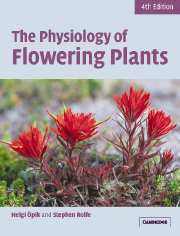Book contents
- Frontmatter
- Contents
- Preface
- Chapter 1 Introduction
- Part I Nutrition and transport
- Chapter 2 Flow of energy and carbon through the plant: photosynthesis and respiration
- Chapter 3 Water relations
- Chapter 4 Mineral nutrition
- Chapter 5 Translocation of organic compounds
- Part II Growth and development
- Appendix
- Index
- References
Chapter 5 - Translocation of organic compounds
Published online by Cambridge University Press: 05 June 2012
- Frontmatter
- Contents
- Preface
- Chapter 1 Introduction
- Part I Nutrition and transport
- Chapter 2 Flow of energy and carbon through the plant: photosynthesis and respiration
- Chapter 3 Water relations
- Chapter 4 Mineral nutrition
- Chapter 5 Translocation of organic compounds
- Part II Growth and development
- Appendix
- Index
- References
Summary
Introduction
Flowering plants are described as being autotrophic, ‘self-feeding’, capable of synthesizing all their organic material via photosynthesis. But a flowering plant is a complex organism with cells and organs specialized for diverse functions, and only the green photosynthetic cells are truly autotrophic; they must accordingly supply all the non-photosynthetic parts with organic carbon. Over small distances, i.e. between individual cells and within small groups of cells, chemicals can move by diffusion through plasmodesmata, or across plasma membranes by diffusion and by active transport. But organic materials must move for long distances; the growing tips of the roots of a tree are many metres away from the nearest photosynthetic leaves and even in a herbaceous plant diffusion would be too slow for the distances involved. We have already seen (Chapter 3) how water moves in plants over long distances in a specialized transport tissue, the xylem. The subject of this chapter is the long-distance, multidirectional movement or translocation of organic compounds which takes place in the phloem.
Phloem as the channel for organic translocation
Evidence for translocation in the phloem
In flowering plants, the xylem is regularly associated with the phloem, the two together making up the vascular tissues. In young organs the two tissues are in contact; when secondary growth occurs they become separated by the vascular cambium, the meristem which then adds xylem to one side and phloem to the other.
- Type
- Chapter
- Information
- The Physiology of Flowering Plants , pp. 133 - 158Publisher: Cambridge University PressPrint publication year: 2005



